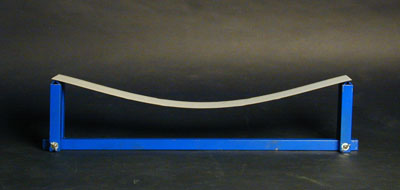Sandwich panel
This is the sighted version that was marked on January 5, 2021. There is 1 pending change that needs to be sighted.
![]()
The articles sandwich construction and sandwich panel overlap thematically. Information that you are looking for here may also be found in the other article.
You are welcome to participate in the relevant redundancy discussion or directly help to merge the articles or to better distinguish them from each other (→ Instructions).
![]()
This article or subsequent section is not sufficiently supported by evidence (e.g., anecdotal evidence). Information without sufficient evidence may be removed in the near future. Please help Wikipedia by researching the information and adding good supporting evidence.
Common sandwich constructions used in the building industry consist of a foam core and two metallic cover layers. In the vast majority of cases, the core is made of polyurethane foam (PUR) or mineral wool (MW). The bond (adhesion or bonding) between the face sheets and the shear-resistant core gives the sandwich panel a high load-bearing capacity and great rigidity.
The linear sandwich theory is used to calculate the load-bearing capacity of sandwich panels.
At the same time, the core ensures very good thermal insulation of the building envelope. Sandwich constructions are quick to assemble and are mainly used in the roof and wall areas of industrial, office and administrative buildings and cold storage facilities. Currently, approx. 12 million m² of sandwich panels are installed in Germany each year. In the whole of Europe this figure is 80-100 million m².
In the context of the major fire at Grenfell Tower in London in June 2017, the use of sandwich panels in fire protection became an issue.

Sandwich with compound

Sandwich without bond
See also
- Sandwich panel with honeycomb core
Questions and Answers
Q: What is a sandwich panel?
A: A sandwich panel is a type of composite material consisting of two components: an outer layer and an inner layer with specific properties such as insulation or fire resistance.
Q: What materials are commonly used for the outer layer of sandwich panels?
A: Aluminium is often used for the outer layer of sandwich panels. These types of sandwich panels are also known as Aluminium Composite Panels.
Q: For what purposes are sandwich panels used?
A: Sandwich panels are used in situations where high structural rigidity and low weight are required. They are also commonly used for cladding, insulation, fire resistance, and aesthetic purposes.
Q: What is the inside layer of a sandwich panel used for?
A: The inside layer of a sandwich panel is used to provide certain properties such as insulation or fire resistance.
Q: Can sandwich panels be used for cladding?
A: Yes, sandwich panels can be used for cladding to add insulation, fire resistance, or just to improve the appearance of a surface.
Q: What is the benefit of using sandwich panels?
A: Sandwich panels are beneficial because they provide high structural rigidity and low weight, making them useful in lightweight construction applications.
Q: How are sandwich panels made?
A: Sandwich panels are made by sandwiching an inner core between two outer layers. The core is often made of materials such as foam, honeycomb, or corrugated metal.
Search within the encyclopedia